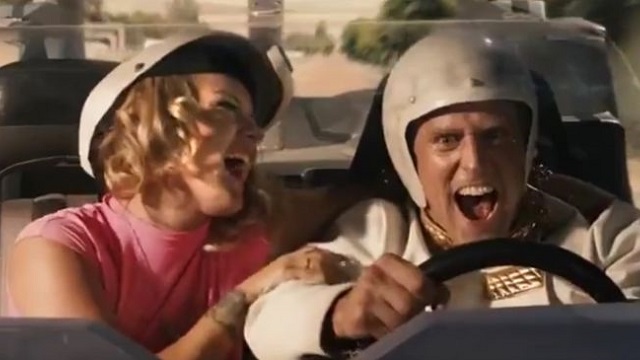Roger Corman loves capitalizing on other films. The most famous example of this was in 1994 when Steven Spielberg’s Jurassic World starring Laura Dern was gathering major publicity, he beat it to theaters by 4 weeks with Carnosaur starring Dern’s mother, Diane Ladd. Back in 1975, Rollerball was gathering publicity as a dystopian film where a fascist government uses an ultraviolent blood sport to quell the masses. Well, Corman beat that movie to theaters when he produced Death Race 2000, a dystopian film where a fascist government uses an ultraviolent blood sport to quell the masses.
Directed by Paul Bartel, Death Race 2000 was far more of a wild campy romp than the grungy depressive world of Rollerball. Starring David Carradine, Sylvester Stallone and Mary Woronov, Death Race 2000 followed the drivers in a Cannonball Run-esque Transcontinental Death Race where the drivers score points for killing innocent people on their routes. In its most inspired gag, an rest home put their most infirm patients out on the street ready to be mowed down, when the driver decides to veer through the parking lot and kill the nurses.
Death Race 2000 was followed by the 1990’s comic book Death Race 2020 and a super-serious reboot series kick-started in 2008 by Paul W.S. Anderson (Resident Evil). Death Race 2050 returns to the low-budget camp affair that made the original Death Race 2000 such an inspired cult hit. Maru Bennett (Spartacus) takes over the role of Frankenstein as an aggressive private solitary driver who resents having to participate in the race. The other drivers come from various modern stereotypes, such as the self-driving vehicle who spends much of his time having sex with his co-pilot, or the shrill white woman who started her own deep friend brand of half-baked christianity. Rounding out these stereotypes are the black woman whose song “Drive Drive Kill Kill” never fails to crack me up, and Sam Perfectus, the genetically engineered chiseled gold-thong-sporting manly man who secretly wishes people could see him as a sensitive type. Malcolm McDowall presides over the event as a Hipster Trump fascist who will stop at nothing to make sure everything goes his way.
Back in the day, Death Race 2000 was a political act against the various conservative and fascistic forces it saw at the time. After two elections of Nixon, and during the last days of the Vietnam War, Death Race 2000 asked what kinds of mass media will exist to distract us from the horrors committed by our government. The wholesale slaughter of innocent civilians was sold as a campy and zesty enterprise giving out points to your favorite sportsman. Little has changed in 50 years, as except for the rise of those corporations and the development of new technologies.
The biggest innovation from Death Race 2000 to Death Race 2050 is the VR Headset. Everybody in America has the capacity to tune in to the Death Race and be put in the passenger seat through the helmets worn by the co-pilots. These headsets blind everybody to their squalid destitute lives in the United Corporations of America. Every city and state has been renamed to better recognize either their squalid status or the corporation that purchased the area.
Roger Corman, who just turned 90 and is still producing movies like these, told Universal that they had removed all the fun out of Death Race with their reboot series. And, it’s true. Death Race wasn’t a film that reveled in the subversive desire to see innocent civilians run down, nor in the politically rebellious nature. Death Race merely thought up a semi-dystopic idea and called it a day. I’m so glad to say that Death Race 2050 brings the series back to its roots, and, even as a half-remake, it’s a helluva bitching time. It may wear out its welcome (Death Race 2050, even at 93 minutes, is still 10 minutes longer than its predecessor) before it hits the finish line, but it never stops wanting to entertain.


